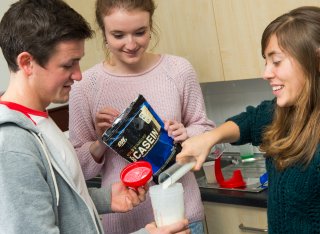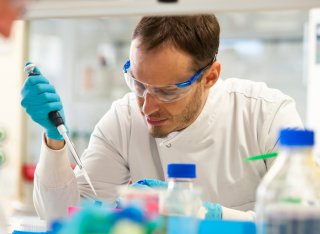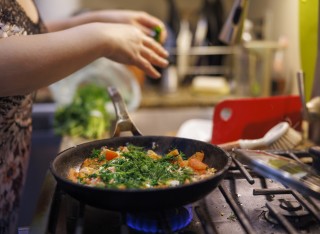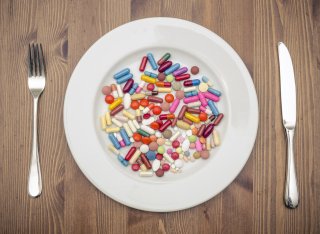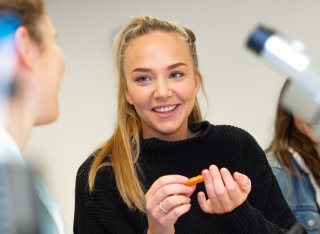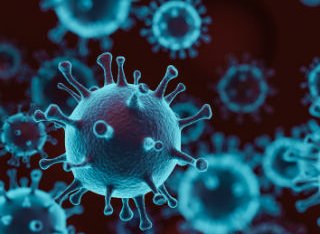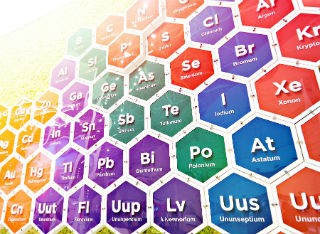
Dr Adam Collins
About
Biography
I have been a qualified nutritionist for over 20 years, completing my undergraduate degree in 1996 before completing an MSc in Nutrition and metabolism and a PhD focusing on energy expenditure and body composition. My ongoing interests lie in obesity, exercise nutrition, body composition and energy metabolism all as can be applied to weight loss/maintenance and metabolic health. Current research includes exercise intensity and energy balance, intermittent fasting, meal timing and composition. Specifically the use of carbohydrate manipulation for metabolic health
I have been committed to undergraduate and postgraduate nutrition education for over 15 years, joining the University of Surrey in 2006. As programme leader for BSc and MSc Nutrition, I am heavily involved in the management and delivery of nutrition education at Surrey.
In 2005, I started a private nutrition consultancy (NutrifficTM), working with companies as a nutrition consultant, undertaking one-to-one nutritional consultations, and commissioned lectures and workshops. I am currently a nutrition consultant for Form (Formnutrition.com) and previously with a commercial weight management company (EurodietTM). I continue to develop external links and collaborations whilst fulfilling a full-time role at Surrey.
Areas of specialism
University roles and responsibilities
- Faculty Postgraduate Taught Coordinator
- Programme Leader for BSc (Hons) Nutrition
- Programme Leader for MSc Human Nutrition
News
In the media
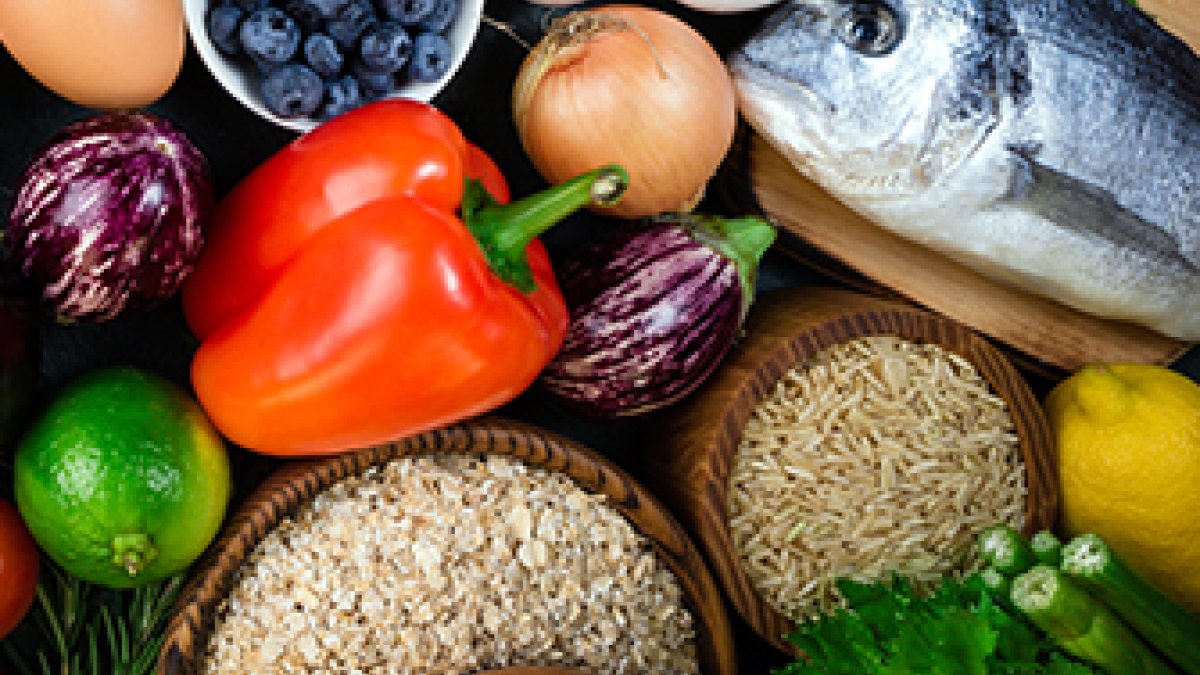
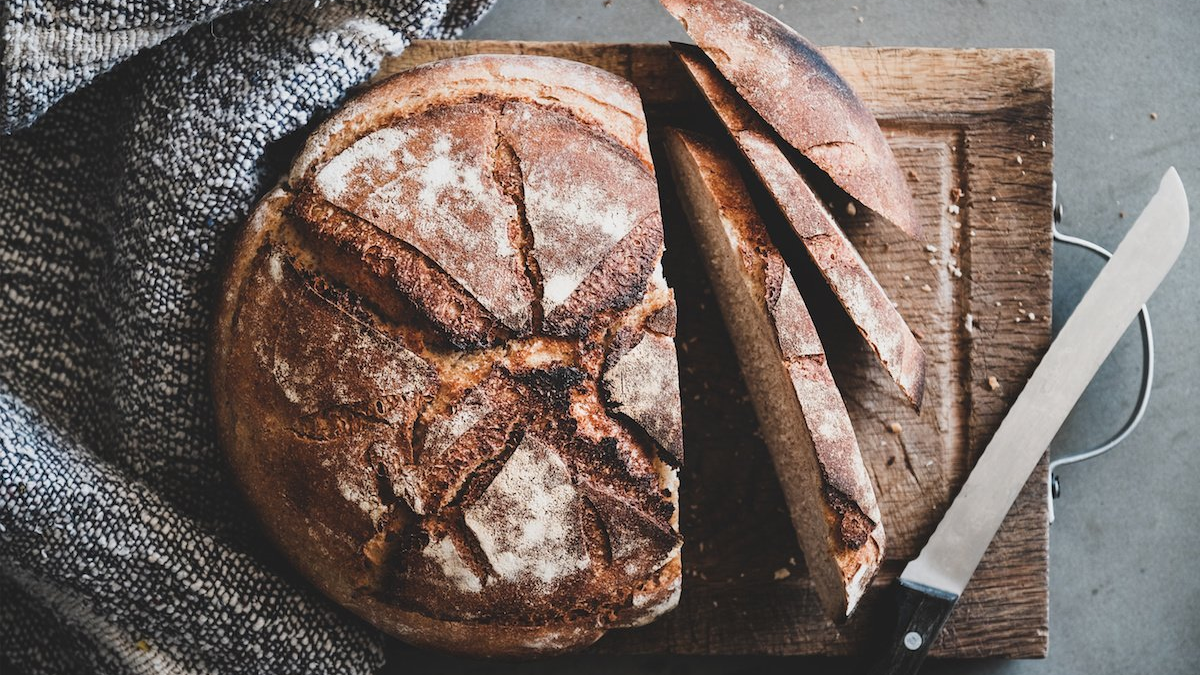
ResearchResearch interests
Obesity and weight loss
Other areas of interest include the measurement of body composition, metabolic rate and energy expenditure, particularly in relation to obesity and weight loss. I am currently interested in the interaction of nutrition and exercise training on energy metabolism for application to weight loss/maintenance. For example:
- Intermittent fasting and time restricted feeding
- The impact of meal timing and meal patterning on metabolic health
- The role of dietary and meal carbohydrate manipulation for cardiometabolic health
- The independent effects of exercise intensity of appetite and energy metabolism
- Timing of nutrition around exercise for improved energy and fat metabolism
Sports nutrition
Previous research has involved nutritional assessment of professional football players and other athletes. I have also been involved in studies looking at the effects of marathon training on bone density. I have built research interests in sports nutrition here at the University of Surrey in collaboration with the new Surrey Sports Park. In particular, with regard to fitness assessment and the effects of nutrition intervention on training and performance.
Current research involves investigating the efficacy of bespoke protein supplementation on exercise training. In addition, examination of longitudinal changes in diet and body composition in young gymnasts.
Body composition and nutritional assessment
Previous work has focused on the validation of Air Displacement Plethysmography (the BODPOD), for the assessment of body composition in a range of individuals. This has also extended into the nutritional assessment of different groups, from professional dancers, professional footballers, the obese and work with the London Fire Brigade. Recent work has included the use of a 3D whole body scanner as a nutritional assessment tool, in collaboration with the London College of Fashion.
I have recently collaborated with Professor Jimmy Bell and the team at the MRC imaging Unit, Imperial College, validating a new bioimpedance method of measuring abdominal adipose tissue compartments (ViScan) against MRI. In addition to ongoing research into the assessment of visceral adiposity in lean and obese individuals and identifying those individuals who may be classed as TOFI (thin on the outside, fat on the inside).
Research interests
Obesity and weight loss
Other areas of interest include the measurement of body composition, metabolic rate and energy expenditure, particularly in relation to obesity and weight loss. I am currently interested in the interaction of nutrition and exercise training on energy metabolism for application to weight loss/maintenance. For example:
- Intermittent fasting and time restricted feeding
- The impact of meal timing and meal patterning on metabolic health
- The role of dietary and meal carbohydrate manipulation for cardiometabolic health
- The independent effects of exercise intensity of appetite and energy metabolism
- Timing of nutrition around exercise for improved energy and fat metabolism
Sports nutrition
Previous research has involved nutritional assessment of professional football players and other athletes. I have also been involved in studies looking at the effects of marathon training on bone density. I have built research interests in sports nutrition here at the University of Surrey in collaboration with the new Surrey Sports Park. In particular, with regard to fitness assessment and the effects of nutrition intervention on training and performance.
Current research involves investigating the efficacy of bespoke protein supplementation on exercise training. In addition, examination of longitudinal changes in diet and body composition in young gymnasts.
Body composition and nutritional assessment
Previous work has focused on the validation of Air Displacement Plethysmography (the BODPOD), for the assessment of body composition in a range of individuals. This has also extended into the nutritional assessment of different groups, from professional dancers, professional footballers, the obese and work with the London Fire Brigade. Recent work has included the use of a 3D whole body scanner as a nutritional assessment tool, in collaboration with the London College of Fashion.
I have recently collaborated with Professor Jimmy Bell and the team at the MRC imaging Unit, Imperial College, validating a new bioimpedance method of measuring abdominal adipose tissue compartments (ViScan) against MRI. In addition to ongoing research into the assessment of visceral adiposity in lean and obese individuals and identifying those individuals who may be classed as TOFI (thin on the outside, fat on the inside).
Supervision
Postgraduate research supervision
Typically, I supervise numerous dissertations a year, on a variety of nutrition topics and both BSc and MSc level.
- Investigating dietary carbohydrate manipulation for metabolic health.
- Predicting weight loss using differential equations (PREDICT).
Teaching
Programme director
- BSc Nutrition
- MSc Human Nutrition
- Faculty PgT Coordinator
Module organiser
- BMS1030 - Biochemistry
- BMS2077- Nutritional Physiology & Metabolism
- BMS3056 - Advances in Nutrition: Energy & Lipid Metabolism
- MHUM007 – Sports & Exercise Nutrition
- Module 11 (MSc Nutritional medicine) – Nutrition for Sports and Exercise Performance
Teaching contributions
- Physiology
- Human Nutrition
- Applied Nutrition
- Key Skills for Nutrition & Dietetics
- Metabolic Nutrition
Departmental duties
I also frequently visit Nutrition and Nutrition/Food Science students whilst on industrial Professional Training Placement.
I am also joint Department Section Lead for Teaching Advancement.
Publications
Highlights
Books and book chapters
Kwong K, Collins AL (2020), Student Perspectives on a nutrition curriculum. In. Enhancing student-centred teaching in higher education. Gravett K, Yakovchuk N, Kincihn I (eds).. Palgrave Macmillan, London. https://www.palgrave.com/gp/book/9783030353957
Sports & Exercise Nutrition: A Nutrition Society Textbook. Lanham-New S, Sheriffs S, Stear S, Collins AL (eds). 2011. Wiley Blackwell, London
Original articles
Biyikoglu H, Robertson MD, Collins AL. Isolating the acute metabolic effects of carbohydrate restriction on postprandial metabolism with or without energy restriction: a crossover study. Eur J Nutr. 2025 Mar 20;64(3):133. doi: 10.1007/s00394-025-03646-5. PMID: 40111529; PMCID: PMC11926029.
Egan AM, Collins AL. Dynamic changes in energy expenditure in response to underfeeding: a review. Proc Nutr Soc. 2021 Oct 4:1-14. doi: 10.1017/S0029665121003669. PMID: 35103583 – 14 citations – impact factor 4.5
Egan A, Rayman J, Rayman M, Collins A. (2024) - Testing a simpl5e mathematical model of weight-loss using data from a commercial weight management company. J Nutr Sci. 2024 Dec 12;13:e92. doi: 10.1017/jns.2024.85. PMID: 39703899; PMCID: PMC11658952
Fan, L.M., Collins, A., Geng, L. et al. Impact of unhealthy lifestyle on cardiorespiratory fitness and heart rate recovery of medical science students. BMC Public Health 20, 1012 (2020). https://doi.org/10.1186/s12889-020-09154-x -
Bhatti, S.N.; Fan, L.M.; Collins, A.; Li, J.-M. Exploration of Alcohol Consumption Behaviours and Health-Related Influencing Factors of Young Adults in the UK. Int. J. Environ. Res. Public Health 2020, 17, 6282. https://doi.org/10.3390/ijerph17176282 -
Nicholas AP, Soto-Mota A, Lambert H, Collins AL. Restricting carbohydrates and calories in the treatment of type 2 diabetes: a systematic review of the effectiveness of 'low-carbohydrate' interventions with differing energy levels. J Nutr Sci. 2021 Sep 14;10:e76. doi: 10.1017/jns.2021.67. PMID: 34589208; PMCID: PMC8453456. -
Antoni R, Johnston KL, Collins AL, Robertson MD . Intermittent versus continuous energy restriction: differential effects on postprandial glucose and lipid metabolism following matched weight-loss in healthy overweight/obese subjects, Br J Nutr, 2018 – 119(5):507-516.
Shamlan G, Bech P, Robertson MD, Collins AL. Acute effects of exercise intensity on subsequent substrate utilisation, appetite, and energy balance in men and women. Appl Physiol Nutr Metab. 2017 Dec;42(12):1247-1253
Antoni R, Johnston KL, Collins AL, Robertson MD. Effects of intermittent fasting on glucose and lipid metabolism. Proc Nutr Soc. 2017 Jan 16:1-8.
Antoni R, Johnston KL, Collins AL, Robertson MD. Investigation into the acute effects of total and partial energy restriction on postprandial metabolism among overweight/obese participants. Br J Nutr. 2016 Mar 28;115(6):951-9
Canaj R, Collins AL, Johnson K, Robertson MD (2014); The Effects of Intermittent Energy Restriction on Indices of Cardiometabolic Health. Research in Endocrinology.
Thomas EL, Parkinson JR, Frost G, Goldstone AP, McCarthy J, Collins AL, Fitzpatrick J, Durighel G, Taylor-Robinson S, Bell JD (2012): The missing risk: accurate phenotyping of abdominal adiposity and ectopic fat. Obesity 20(1):76-87.
Thomas EL, Collins AL, McCarthy J, Durighel G, Fitzpatrick J, Goldstone A, Bell J (2010): Estimation of abdominal fat compartments by bioelectrical impedance: The validity of the ViScan measurement system in comparison with MRI. EJCN. 64, 525-37
Drysdale IP, Collins AL, Walters NJ, Bird D, Hinkley HJ. (2007): Potential benefits of marathon training on bone health as assessed by calcaneal broadband ultrasound attenuation. J Clin Densitom. 10(2):179-83.
Collins AL, Saunders S, McCarthy HD, Williams JE, Fuller NJ (2003): Within- and between-laboratory variability in air displacement plethysmography. Int J Obes. 28; 80-90
Collins AL & McCarthy HD (2003): Evaluation of factors determining the precision of body composition measurements by air displacement plethysmography. Eur J Clin Nutr. 57; 770-776
Exercise is capable of influencing the regulation of energy balance by acutely modulating appetite and energy intake coupled to effects on substrate utilization. Yet, few studies have examined acute effects of exercise intensity on aspects of both energy intake and energy metabolism, independently of energy cost of exercise. Furthermore, little is known as to the gender differences of these effect. One hour after a standardised breakfast, 40 (19 female), healthy participants (BMI 23.6±3.6 kg.m-2, VO2peak 34.4±6.8 ml.min-1.min-1) undertook either High intensity intermittent cycling consisting of 8 repeated 60s bouts of cycling at 95% VO2peak (HIIC) or low intensity continuous cycling, equivalent to 50% VO2peak (LICC), matched for energy cost (~950kJ) followed by 90mins of rest, in a randomised crossover design. Throughout each study visit satiety was assessed subjectively using visual analogue scales alongside blood metabolites and GLP-1. Energy expenditure and substrate utilization were measured over 75 minutes post-exercise via indirect calorimetry. Energy intake was assessed for 48hours post-intervention. No differences in appetite, GLP-1 or energy intakes were observed between HIIC and LICC, with or without stratifying for gender. Significant differences in post exercise non-esterified fatty acid (NEFA) concentrations were observed between intensities in both genders, coupled to a significantly lower respiratory exchange ratio (RER) following HIIC (P=0.0028), with a trend towards greater reductions in RER in men(P=0.079). In conclusion, high intensity exercise, if energy matched, does not lead to greater appetite or energy intake but may exert additional beneficial metabolic effects that may be more pronounced in males.
Now widely adopted on courses throughout the world, the prestigious Nutrition Society Textbook series provides students with the scientific basics in nutrition in the context of a systems and disease approach rather than on a nutrient by nutrient basis. In addition books provide a means to enable teachers and students to explore the core principles of nutrition and to apply these throughout their training to foster critical thinking at all times. This NS Textbook on Sport and Exercise Nutrition has been written to cover the latest information on the science and practice of sport and exercise nutrition. A key concept behind this textbook is that it aims to combine the viewpoints of world leading nutrition experts from both academia/research and a practical stand point. Plus where necessary there are additional practitioner based authors to ensure theory is translated into practice for each chapter in the form of either 'practice tips' or 'information sheets' at the end of relevant chapters. The textbook in essence can be divided into three distinct but integrated parts: Part 1: covers the key components of the science that supports the practice of sport and exercise nutrition including comprehensive reviews on: nutrients both in general and as exercise fuels; exercise physiology; hydration, micronutrients; and supplements. Part 2: moves into focusing on specific nutrition strategies to support different types of training including: resistance; power/sprint; middle distance/speed endurance; endurance; technical/skill, team; and specific competition nutrition needs. The unique format of this textbook is that it breaks down nutrition support into training specific as opposed to the traditional sport specific support. This reflects the majority of current sport and exercise requirements of the need to undertake concurrent training and therefore facilitating targeted nutrition support to the different training components through the various macro and micro training cycles. Part 3: explores some of the practical issues encountered in working in the sport and exercise nutrition field and includes key sport related topics such as: disability sport; weight management; eating disorders; bone and gut health; immunity; injury; travel; and special populations and situations. READERSHIP: Students of nutrition and dietetics at both undergraduate and postgraduate level. All those working in the field of nutrition and related health sciences. © 2011 The Nutrition Society.
The intermittent energy restriction (IER) approach to weight-loss involves short periods of substantial (>70%) energy restriction interspersed with normal eating. Studies to date comparing IER to continuous energy restriction (CER) have predominantly measured fasting indices of cardiometabolic risk. This study aimed to compare the effects of IER and CER on postprandial glucose and lipid metabolism following matched weight-loss. 27 (13 male) overweight/obese participants (46±3y, 30.1±1.0kg/m2) were randomised to either an IER (2638 kJ for two days/week with an overall ER of 22±0.3%, n=15) or CER (2510kJ below requirements with overall ER of 23±0.8%) intervention. Six-hour postprandial responses to a test meal and changes in anthropometry (fat mass, fat-free mass, circumferences) were assessed at baseline and upon attainment of 5% weight-loss, following a 7 day period of weight stabilisation. The study found no significant difference in the time to attain a 5% weight loss between groups (median 59 [41-70] days and 73 [48-128] days respectively, p=0.246), or in body composition (p≥0.430). For postprandial measures, neither diet significantly altered glycaemia (p=0.226), whereas insulinaemia was reduced comparatively (p=0.903). The reduction in c-peptide tended (p=0.057) to be greater following IER (309128±23268 to 247781±20709 pmol.360min.L-1) versus CER (297204±25112 to 301655±32714 pmol.360min.L-1). The relative reduction in triacylglycerol responses was greater (p=0.045) following IER (106±30 to 68±15 mmol.360min.L-1) compared to CER (117±43 to 130±31 mmol.360min.L-1). In conclusion, these preliminary findings highlight underlying differences between IER and CER, including a superiority of IER in reducing postprandial lipaemia, which now warrant targeted mechanistic evaluation within larger study cohorts.

